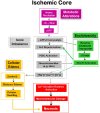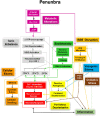Physiopathology of ischemic stroke and its modulation using memantine: evidence from preclinical stroke
- PMID: 32985462
- PMCID: PMC7996012
- DOI: 10.4103/1673-5374.293129
Physiopathology of ischemic stroke and its modulation using memantine: evidence from preclinical stroke
Abstract
Ischemic stroke is the most common type of cerebrovascular disease and is caused by an interruption of blood flow in the brain. In this disease, two different damage areas are identifying: the lesion core, in which cells quickly die; and the penumbra (surrounding the lesion core), in which cells are functionally weakened but may recover and restore their functions. The currently approved treatments for ischemic stroke are the recombinant tissue plasminogen activator and endovascular thrombectomy, but they have a short therapeutic window (4.5 and 6 hours after stroke onset, respectively) and a low percentage of stroke patients actually receive these treatments. Memantine is an approved drug for the treatment of Alzheimer's disease. Memantine is a noncompetitive, low affinity and use-dependent antagonist of N-methyl-D-aspartate glutamate receptor. Memantine has several advantages over developing a new drug to treat focal ischemic stroke, but the most important is that it has sufficient safe probes in preclinical models and humans, and if the preclinical studies provide more evidence about pharmacological actions in tissue protection and repair, this could help to increase the number of clinical trials. The present review summarizes the physiopathology of isquemic stroke and the pharmacological actions in neuroprotection and neuroplasticity of memantine in the post stroke stage of preclinical stroke models, to illustrate their potential to improve functional recovery in human patients.
Keywords: focal ischemic stroke; memantine; neuroplasticity; neuroprotection; stroke therapy.
Conflict of interest statement
None
Figures



References
Publication types
LinkOut - more resources
Full Text Sources
Other Literature Sources

